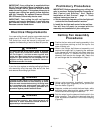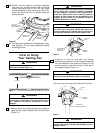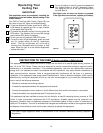
Operating Your
Ceiling Fan
IMPORTANT
Fan installation must be completed, including the
installation of the fan blades, before testing of the
remote control.
Your SW116 Fan/Light Wall Control (Figure 25) has
full control of your fan, lights, and airflow direction.
1.To set the desired fan speed, push the HI, MED, or
LOW buttons to operate your fan on high, medium
or low speed (See Figure 25).
2.To reverse the direction the fan is turning, press the
REV button. The direction the fan turns will change
each time the REV button is pressed.
3.To turn your fan off, press the FAN OFF button.
4. To set the level of light brightness, press and hold
the U/L (uplight) button or the D/L (downlight)
button. The light brightness will continue to
increase then decrease while the button is held
down. When the light is at the desired brightness,
release the button.
HI
MED
LOW
FAN OFF
REV
EMERSON
D/L
U/L
Figure 25
5. To turn the lights on and off, press and release the
U/L (uplight) button or the D/L (downlight) button.
The lights will turn on at the light level previously
set (see Step 4).
Red light turns on when any button is pressed.
If the light does not come on, replace your battery.
INSTRUCTION TO THE USER (if device contains a digital device)
This equipment has been tested and found to comply with the limits for a class B digital device, pursuant to
part 15 of the FCC Rules. These limits are designed to provide reasonable protection against harmful
interference in a residential installation. This equipment generates, uses and can radiate radio frequency
energy and if no installed and used in accordance with the instructions, may cause harmful interference to
radio communications. However, there is not guarantee that interference will not occur in a particular
installation. If this equipment does cause harmful interference to radio or television reception, which can be
determined by turning the equipment off and on, the user is encouraged to try to correct the interference by
one or more of the following measures:
• Reorient or relocate the receiving antenna.
• Increase the separation between the equipment and receiver.
• Connect the equipment into an outlet on a circuit different from that to which the receiver is connected.
• Consult the dealer or an experienced radio/TV technician for help.
This equipment has been certified to comply with the limits for a class B computing device, pursuant to FCC
Rules. In order to maintain compliance with FCC regulations, shielded cables must be used with this
equipment. Operation with non-approved equipment or unshielded cables is likely to result in interference to
radio and TV reception. The user is cautioned that changes and modifications made to the equipment without
the approval of manufacturer could void the user’s authority to operate this equipment.
This Class B digital apparatus meets all requirements of the Canadian Interference-Causing Equipment
Regulations.
12


















